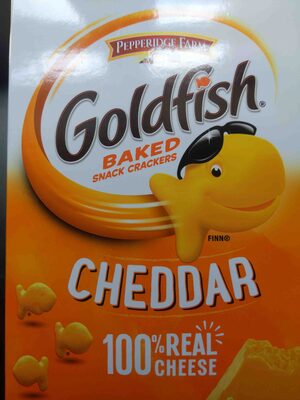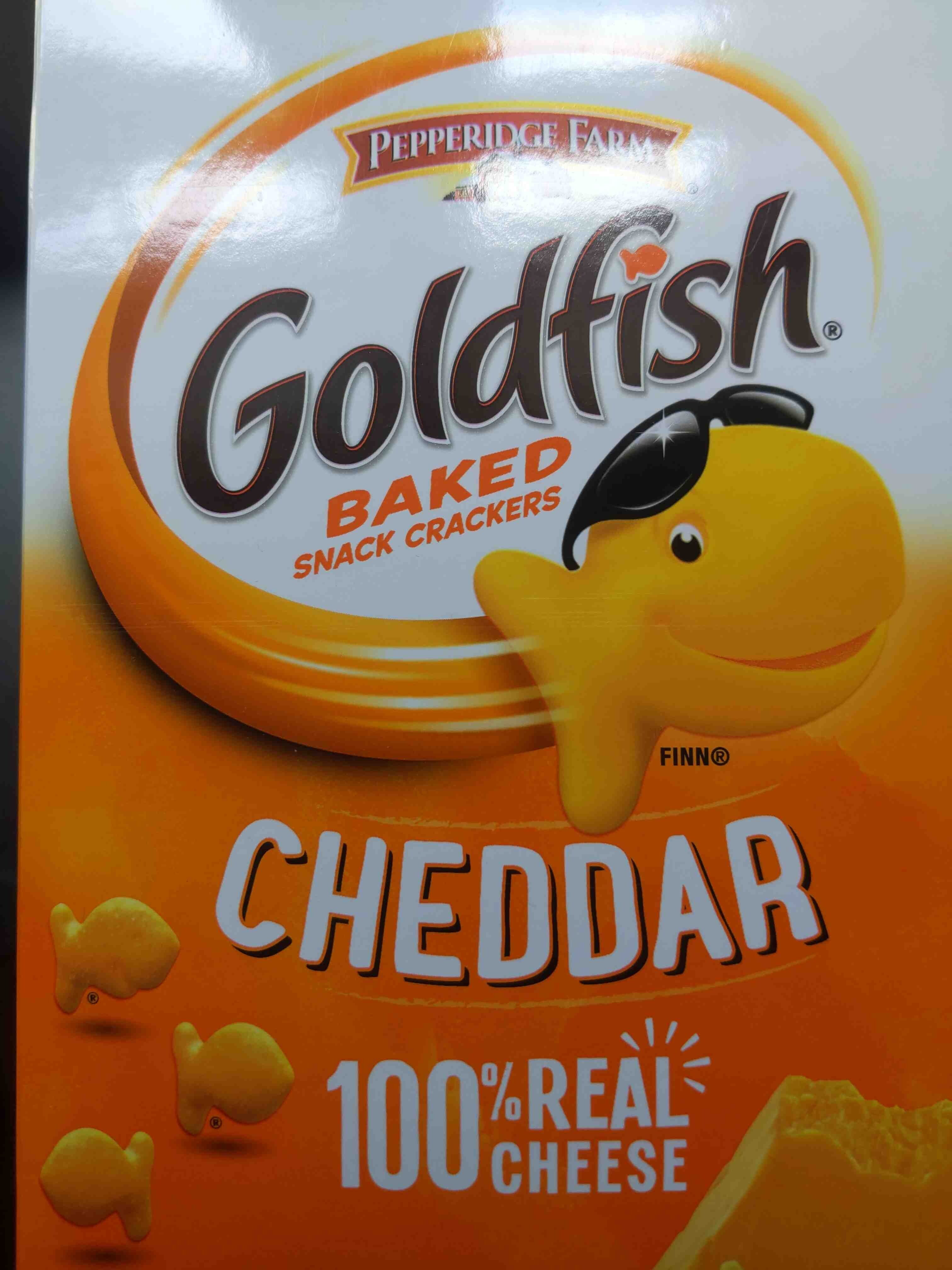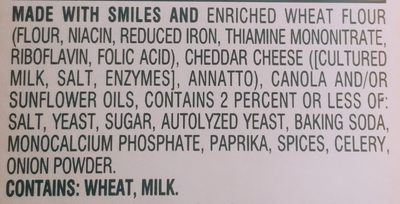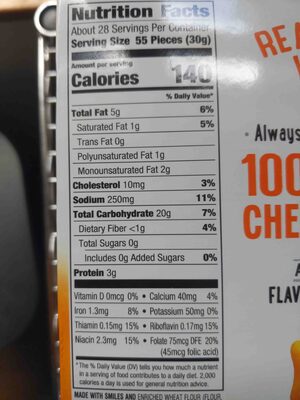Help us make food transparency the norm!
As a non-profit organization, we depend on your donations to continue informing consumers around the world about what they eat.
The food revolution starts with you!
Goldfish crackers - Pepperidge Farms - 30 oz
Goldfish crackers - Pepperidge Farms - 30 oz
This product page is not complete. You can help to complete it by editing it and adding more data from the photos we have, or by taking more photos using the app for Android or iPhone/iPad. Thank you!
×
Barcode: 0014100096559 (EAN / EAN-13) 014100096559 (UPC / UPC-A)
Quantity: 30 oz
Brands: Pepperidge Farms
Brand owner: PEPPERIDGE FARM
Categories: Snacks, Salty snacks, Sweet snacks, Appetizers, Biscuits and cakes, Biscuits, Crackers
Labels, certifications, awards: Baked with real cheese
Countries where sold: United States
Matching with your preferences
Health
Ingredients
-
20 ingredients
Wheat flour, niacin, reduced iron, thiamine mononitrate, riboflavin, folic acid, cheddar cheese ([cultured milk, salt, enzymes], annatto), canola, sunflower oils, salt, yeast, sugar, autolyzed yeast, baking soda, monocalcium phosphate, paprika, spices, celery, onion powderAllergens: Celery, Gluten, Milk
Food processing
-
Ultra processed foods
Elements that indicate the product is in the 4 - Ultra processed food and drink products group:
- Additive: E160b - Annatto
Food products are classified into 4 groups according to their degree of processing:
- Unprocessed or minimally processed foods
- Processed culinary ingredients
- Processed foods
- Ultra processed foods
The determination of the group is based on the category of the product and on the ingredients it contains.
Additives
-
E341 - Calcium phosphates
Calcium phosphate: Calcium phosphate is a family of materials and minerals containing calcium ions -Ca2+- together with inorganic phosphate anions. Some so-called calcium phosphates contain oxide and hydroxide as well. They are white solids of nutritious value.Source: Wikipedia
-
E341i - Monocalcium phosphate
Calcium phosphate: Calcium phosphate is a family of materials and minerals containing calcium ions -Ca2+- together with inorganic phosphate anions. Some so-called calcium phosphates contain oxide and hydroxide as well. They are white solids of nutritious value.Source: Wikipedia
-
E500 - Sodium carbonates
Sodium carbonates (E500) are compounds commonly used in food preparation as leavening agents, helping baked goods rise by releasing carbon dioxide when they interact with acids.
Often found in baking soda, they regulate the pH of food, preventing it from becoming too acidic or too alkaline. In the culinary world, sodium carbonates can also enhance the texture and structure of foods, such as noodles, by modifying the gluten network.
Generally recognized as safe, sodium carbonates are non-toxic when consumed in typical amounts found in food.
-
E500ii - Sodium hydrogen carbonate
Sodium hydrogen carbonate, also known as E500ii, is a food additive commonly used as a leavening agent.
When added to recipes, it releases carbon dioxide gas upon exposure to heat or acids, causing dough to rise and resulting in a light, fluffy texture in baked goods.
It is generally recognized as safe (GRAS) by regulatory authorities when used in appropriate quantities and poses no significant health risks when consumed in typical food applications.
Ingredients analysis
-
Palm oil free
No ingredients containing palm oil detected
Unrecognized ingredients: Autolyzed-yeastSome ingredients could not be recognized.
We need your help!
You can help us recognize more ingredients and better analyze the list of ingredients for this product and others:
- Edit this product page to correct spelling mistakes in the ingredients list, and/or to remove ingredients in other languages and sentences that are not related to the ingredients.
- Add new entries, synonyms or translations to our multilingual lists of ingredients, ingredient processing methods, and labels.
If you would like to help, join the #ingredients channel on our Slack discussion space and/or learn about ingredients analysis on our wiki. Thank you!
-
Non-vegan
Non-vegan ingredients: CheddarSome ingredients could not be recognized.
We need your help!
You can help us recognize more ingredients and better analyze the list of ingredients for this product and others:
- Edit this product page to correct spelling mistakes in the ingredients list, and/or to remove ingredients in other languages and sentences that are not related to the ingredients.
- Add new entries, synonyms or translations to our multilingual lists of ingredients, ingredient processing methods, and labels.
If you would like to help, join the #ingredients channel on our Slack discussion space and/or learn about ingredients analysis on our wiki. Thank you!
-
Vegetarian status unknown
Unrecognized ingredients: Reduced iron, Thiamin mononitrate, Folic acid, Autolyzed-yeastSome ingredients could not be recognized.
We need your help!
You can help us recognize more ingredients and better analyze the list of ingredients for this product and others:
- Edit this product page to correct spelling mistakes in the ingredients list, and/or to remove ingredients in other languages and sentences that are not related to the ingredients.
- Add new entries, synonyms or translations to our multilingual lists of ingredients, ingredient processing methods, and labels.
If you would like to help, join the #ingredients channel on our Slack discussion space and/or learn about ingredients analysis on our wiki. Thank you!
-
Details of the analysis of the ingredients
We need your help!
Some ingredients could not be recognized.
We need your help!
You can help us recognize more ingredients and better analyze the list of ingredients for this product and others:
- Edit this product page to correct spelling mistakes in the ingredients list, and/or to remove ingredients in other languages and sentences that are not related to the ingredients.
- Add new entries, synonyms or translations to our multilingual lists of ingredients, ingredient processing methods, and labels.
If you would like to help, join the #ingredients channel on our Slack discussion space and/or learn about ingredients analysis on our wiki. Thank you!
en: Wheat flour, niacin, reduced iron, thiamine mononitrate, riboflavin, folic acid, cheddar cheese (annatto), canola, sunflower oils, salt, yeast, sugar, autolyzed yeast, baking soda, monocalcium phosphate, paprika, spices, celery, onion- Wheat flour -> en:wheat-flour - vegan: yes - vegetarian: yes - ciqual_proxy_food_code: 9410 - percent_min: 5.26315789473684 - percent_max: 100
- niacin -> en:e375 - vegan: maybe - vegetarian: maybe - percent_min: 0 - percent_max: 50
- reduced iron -> en:reduced-iron - percent_min: 0 - percent_max: 33.3333333333333
- thiamine mononitrate -> en:thiamin-mononitrate - percent_min: 0 - percent_max: 25
- riboflavin -> en:e101 - vegan: maybe - vegetarian: yes - percent_min: 0 - percent_max: 20
- folic acid -> en:folic-acid - percent_min: 0 - percent_max: 16.6666666666667
- cheddar cheese -> en:cheddar - vegan: no - vegetarian: maybe - ciqual_food_code: 12726 - percent_min: 0 - percent_max: 14.2857142857143
- annatto -> en:e160b - vegan: yes - vegetarian: yes - percent_min: 0 - percent_max: 14.2857142857143
- canola -> en:canola - vegan: yes - vegetarian: yes - percent_min: 0 - percent_max: 12.5
- sunflower oils -> en:sunflower-oil - vegan: yes - vegetarian: yes - from_palm_oil: no - ciqual_food_code: 17440 - percent_min: 0 - percent_max: 11.1111111111111
- salt -> en:salt - vegan: yes - vegetarian: yes - ciqual_food_code: 11058 - percent_min: 0 - percent_max: 0.833
- yeast -> en:yeast - vegan: yes - vegetarian: yes - percent_min: 0 - percent_max: 0.833
- sugar -> en:sugar - vegan: yes - vegetarian: yes - ciqual_proxy_food_code: 31016 - percent_min: 0 - percent_max: 0
- autolyzed yeast -> en:autolyzed-yeast - percent_min: 0 - percent_max: 0
- baking soda -> en:e500ii - vegan: yes - vegetarian: yes - percent_min: 0 - percent_max: 0
- monocalcium phosphate -> en:e341i - vegan: yes - vegetarian: yes - percent_min: 0 - percent_max: 0
- paprika -> en:paprika - vegan: yes - vegetarian: yes - ciqual_food_code: 11049 - percent_min: 0 - percent_max: 0
- spices -> en:spice - vegan: yes - vegetarian: yes - percent_min: 0 - percent_max: 0
- celery -> en:celery - vegan: yes - vegetarian: yes - ciqual_proxy_food_code: 20055 - percent_min: 0 - percent_max: 0
- onion -> en:onion - vegan: yes - vegetarian: yes - ciqual_food_code: 20034 - percent_min: 0 - percent_max: 0
Nutrition
-
Average nutritional quality
⚠ ️Warning: the amount of fruits, vegetables and nuts is not specified on the label, it was estimated from the list of ingredients: 0This product is not considered a beverage for the calculation of the Nutri-Score.
Positive points: 5
- Proteins: 5 / 5 (value: 10, rounded value: 10)
- Fiber: 5 / 5 (value: 11, rounded value: 11)
- Fruits, vegetables, nuts, and colza/walnut/olive oils: 0 / 5 (value: 0.370065789473685, rounded value: 0.4)
Negative points: 11
- Energy: 5 / 10 (value: 1950, rounded value: 1950)
- Sugars: 0 / 10 (value: 0, rounded value: 0)
- Saturated fat: 3 / 10 (value: 3.33, rounded value: 3.3)
- Sodium: 3 / 10 (value: 333, rounded value: 333)
The points for proteins are not counted because the negative points are greater or equal to 11.
Nutritional score: (11 - 5)
Nutri-Score:
-
Nutrient levels
-
Fat in moderate quantity (16.7%)
What you need to know- A high consumption of fat, especially saturated fats, can raise cholesterol, which increases the risk of heart diseases.
Recommendation: Limit the consumption of fat and saturated fat- Choose products with lower fat and saturated fat content.
-
Saturated fat in moderate quantity (3.33%)
What you need to know- A high consumption of fat, especially saturated fats, can raise cholesterol, which increases the risk of heart diseases.
Recommendation: Limit the consumption of fat and saturated fat- Choose products with lower fat and saturated fat content.
-
Sugars in low quantity (0%)
What you need to know- A high consumption of sugar can cause weight gain and tooth decay. It also augments the risk of type 2 diabetes and cardio-vascular diseases.
Recommendation: Limit the consumption of sugar and sugary drinks- Sugary drinks (such as sodas, fruit beverages, and fruit juices and nectars) should be limited as much as possible (no more than 1 glass a day).
- Choose products with lower sugar content and reduce the consumption of products with added sugars.
-
Salt in moderate quantity (0.833%)
What you need to know- A high consumption of salt (or sodium) can cause raised blood pressure, which can increase the risk of heart disease and stroke.
- Many people who have high blood pressure do not know it, as there are often no symptoms.
- Most people consume too much salt (on average 9 to 12 grams per day), around twice the recommended maximum level of intake.
Recommendation: Limit the consumption of salt and salted food- Reduce the quantity of salt used when cooking, and don't salt again at the table.
- Limit the consumption of salty snacks and choose products with lower salt content.
-
-
Nutrition facts
Nutrition facts As sold
for 100 g / 100 mlAs sold
per serving (30g)Compared to: Crackers Energy 1,950 kj
(467 kcal)586 kj
(140 kcal)+3% Fat 16.7 g 5 g -3% Saturated fat 3.33 g 1 g -17% Monounsaturated fat 27.8 g 8.33 g +290% Polyunsaturated fat 11.1 g 3.33 g +89% Trans fat 0 g 0 g Cholesterol 110 mg 33 mg +4,004% Carbohydrates 66.7 g 20 g +8% Sugars 0 g 0 g -100% Fiber 11 g 3.3 g +173% Proteins 10 g 3 g +4% Salt 0.833 g 0.25 g -55% Vitamin A 0 µg 0 µg -100% Vitamin C (ascorbic acid) 0 mg 0 mg -100% Vitamin B1 (Thiamin) 0 mg 0 mg -100% Vitamin B2 (Riboflavin) 1.89 mg 0.567 mg +354% Vitamin B3/PP (Niacin) 17.8 mg 5.333 mg +227% Folates (total folates) 443 µg 133 µg +173% Calcium 443 mg 133 mg +574% Iron 12 mg 3.6 mg +285% Fruits‚ vegetables‚ nuts and rapeseed‚ walnut and olive oils (estimate from ingredients list analysis) 0.37 % 0.37 %
Environment
-
Eco-Score B - Low environmental impact
⚠ ️Select a country in order to include the full impact of transportation.The Eco-Score is an experimental score that summarizes the environmental impacts of food products.→ The Eco-Score was initially developped for France and it is being extended to other European countries. The Eco-Score formula is subject to change as it is regularly improved to make it more precise and better suited to each country.Life cycle analysis
-
Average impact of products of the same category: A (Score: 87/100)
Category: Salty snacks, crackers, plain
Category: Salty snacks, crackers, plain
- PEF environmental score: 0.22 (the lower the score, the lower the impact)
- including impact on climate change: 1.59 kg CO2 eq/kg of product
Stage Impact Agriculture
59.7 %Processing
22.4 %Packaging
10.6 %Transportation
5.2 %Distribution
2.2 %Consumption
0.0 %
Bonuses and maluses
-
Missing origins of ingredients information
Malus: -5
⚠ ️ The origins of the ingredients of this product are not indicated.
If they are indicated on the packaging, you can modify the product sheet and add them.
If you are the manufacturer of this product, you can send us the information with our free platform for producers.
-
Packaging with a medium impact
Malus: -10
Shape Material Recycling Impact Box Unknown High ⚠ ️ The information about the packaging of this product is not sufficiently precise (exact shapes and materials of all components of the packaging).⚠ ️ For a more precise calculation of the Eco-Score, you can modify the product page and add them.
If you are the manufacturer of this product, you can send us the information with our free platform for producers.
Eco-Score for this product
-
Impact for this product: B (Score: 72/100)
Product: Goldfish crackers - Pepperidge Farms - 30 oz
Life cycle analysis score: 87
Sum of bonuses and maluses: -15
Final score: 72/100
-
Carbon footprint
-
Equal to driving 0.8 km in a petrol car
159 g CO² per 100g of product
The carbon emission figure comes from ADEME's Agribalyse database, for the category: Salty snacks, crackers, plain (Source: ADEME Agribalyse Database)
Stage Impact Agriculture
53.6 %Processing
18.8 %Packaging
17.7 %Transportation
8.7 %Distribution
1.2 %Consumption
0.0 %
Packaging
-
Packaging with a medium impact
-
Packaging parts
Box
-
Packaging materials
Material % Packaging weight Packaging weight per 100 g of product
-
Transportation
-
Origins of ingredients
Missing origins of ingredients information
⚠ ️ The origins of the ingredients of this product are not indicated.
If they are indicated on the packaging, you can modify the product sheet and add them.
If you are the manufacturer of this product, you can send us the information with our free platform for producers.Add the origins of ingredients for this product Add the origins of ingredients for this product
Report a problem
-
Incomplete or incorrect information?
Category, labels, ingredients, allergens, nutritional information, photos etc.
If the information does not match the information on the packaging, please complete or correct it. Open Food Facts is a collaborative database, and every contribution is useful for all.
Data sources
Product added on by openfoodfacts-contributors
Last edit of product page on by .
Product page also edited by bdwyer, chiefofgxbxl, gavingt, inf, org-database-usda, packbot, somkun, swipe-studio, tacinte, teolemon.










